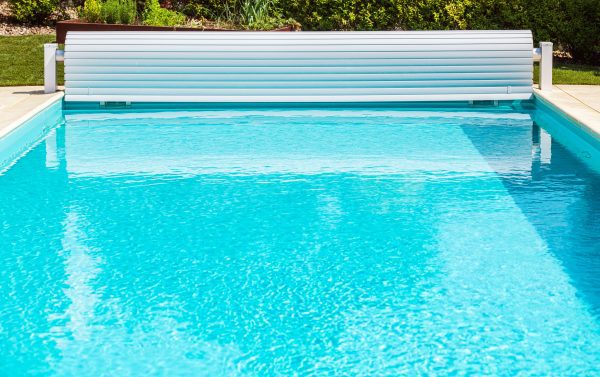Swimming pools provide leisure and fun, but they also need protection, especially when not in use. That’s where pool covers come into play. They offer a wide range of benefits, from safety to energy savings. Let’s uncover the details of different pool covers.
1. Solar Covers:
Solar covers resemble a giant sheet of bubble wrap. Their design traps the sun’s warmth and transfers it to the pool.
- Pros:
- Heat Magnet: Captures the sun’s energy to warm up the pool.
- Cost-Efficient: Generally affordable and can save money on heating bills.
- Evaporation Barrier: Reduces water loss, conserving your pool’s chemical balance.
- Cons:
- Fragile: Cannot bear heavy weights like debris or snow.
- Short-Lived: UV exposure can degrade the plastic, reducing its lifespan.
2. Safety Covers:
Constructed from solid vinyl or mesh material, these are stretched tight across the pool, anchored by brackets installed into the pool deck.
- Pros:
- Child & Pet Safe: Sturdy enough to support the weight of children and pets.
- Long-Lasting: Resilient materials promise longevity.
- Cleanliness: Provides a barrier against dirt and debris.
- Cons:
- Higher Cost: Quality comes at a price.
- Installation: Needs anchors, which might not be suitable for all pool decks.
3. Automatic Covers:
A modern marvel, these covers roll out from an installed reel system, often located at one end of the pool.
- Pros:
- User-Friendly: Simple push-button operation.
- Energy Savings: Maintains water temperature, reducing heating bills.
- Safety First: Prevents unsupervised pool access.
- Cons:
- Price Tag: Comes with a significant initial investment.
- Upkeep: Mechanical parts may need occasional maintenance.
4. Mesh Covers:
These covers are lightweight, made of a mesh material that covers the pool but allows water (like rain) to seep through.
- Pros:
- Easy Handling: Lighter than solid covers, making it easier to install and remove.
- No Puddles: Water goes through, ensuring no waterlogging on top.
- Barrier: Blocks larger debris while allowing water passage.
- Cons:
- Not Completely Clear: Allows finer particles to pass through.
- Lack of Insulation: Water can get cold as heat escapes through the mesh.
5. Winter Covers:
These are tarplike covers, usually held in place with water bags or weights around the pool’s edge.
- Pros:
- Seasonal Shield: Designed to guard your pool during the colder months.
- Cost-Effective: More affordable than some high-end cover types.
- Protection: Acts as a shield against winter debris.
- Cons:
- Safety Concerns: Not designed to hold weight; water buildup or snow could cause it to sag.
- Wear & Tear: Vulnerable to damage from heavy snow or ice accumulation.
Conclusion:
The world of pool covers offers a plethora of choices, each designed for specific needs and benefits. From keeping your pool warm with a solar cover to ensuring its safety with a sturdy safety cover, the options are vast. Ensure you pick what’s best for your pool, taking into account your local climate, budget, and pool usage patterns. And remember, the right cover can be both a protector and a penny saver!
